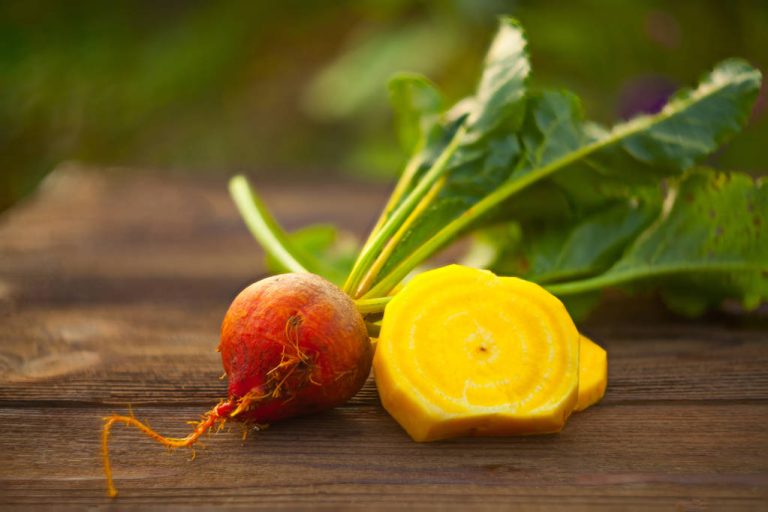How many types of tomatoes are there in your supermarket? And how many purple carrots? The variety of our vegetables had to give way to industrialized agriculture a long time ago. Only what yields as much yield as possible is bred. Old vegetable varieties, on the other hand, are being forgotten. Or do you know Bamberger Hörnchen, Mairübe or Purple Dragon?
With the original diversity of fruit and vegetable varieties, varieties that are particularly well adapted to certain locations, that are pest-resistant, robust and of course particularly tasty are simply lost – irretrievably. At least if no one “saves” the seeds of the old vegetable varieties.

The yellow beets
Beetroot has made a successful comeback in recent years – and is even revered as a superfood. But who knows their relative, the yellow beet? As the name suggests, the bulbs are bright yellow, have a pleasantly fruity flavor and are slightly milder and sweeter than most beets. By the way, there are also white and white-beetroot. The colorful tubers are prepared just like the well-known beetroot, all of which are available regionally from September to April. Recommendation: prepare yellow and beetroot separately, otherwise the red color of the yellow root will steal the show…
Old potato variety: the Bamberger Hörnchen
It is quite possible that you have previously known exactly two types of potatoes: firm and mealy. There are a multitude of different varieties – from thick to thin, small to large, round to curved, in yellow, red, black and blue, with such beautiful names as Ackersegen, Rosa Tannenspitzen or Black Ungarin.
The Bamberger Hörnchen (also Bamberger Hörnle, Barmberger Hörnla) is an almost forgotten local variety and as such a “passenger” in the Ark of Taste. The tubers are thin, about a finger long and slightly curved. They have light yellow flesh, a firm consistency and a fine, slightly nutty taste. Because cultivation under conventional conditions is uneconomical, the “Bamberger Hörnchen” is only occasionally cultivated – but the tubers can be found at some weekly markets. If you discover them, you should definitely taste them and thus contribute to their preservation
Old vegetable variety: the May turnip
May turnips (also: navette) are – the name gives it away – mainly available in May and well into June. But: You can also buy the white turnips in autumn. For a long time, turnips were supplanted by potatoes, and it’s only been a few years since they’ve been found more frequently at weekly markets and in greengrocers’ shops. The taste of the beets is reminiscent of radishes or radishes, but they are milder. You can eat everything from the leaves to the tuber – for example raw in a salad, boiled in salt water until soft or fried and glazed.
The purple carrot: Purple Dragon
Surprise: Not all carrots are just orange. There are several old and rare varieties in white, yellow and purple – such as this one with the beautiful name Purple Dragon: purple on the outside, bright orange on the inside. “It has a fine, sweet-aromatic taste and is fast-growing, so very late sowings are still possible,” writes the Arche Noah association. You can find the purple carrots at weekly markets or at greengrocers.
Also an old vegetable: the parsnip
Although the parsnip has recently resurfaced from near oblivion, it is still a long way from being represented in all supermarkets. Parsnips were an important food for a long time – only with the discovery of potatoes did they go out of fashion. However, the root vegetables can be found at many weekly markets and in organic shops. The root is a typical winter vegetable and is available regionally from October to March. It tastes a bit like carrot, but milder, sweeter, and a little bit nutty. Parsnips can be prepared like carrots and potatoes: boiled, baked in a casserole or as “fries” in the oven (very tasty!), fried, made into a puree or soup.
Rare tomato varieties: Black Cherry, Goldita and Little Red Riding Hood
It is estimated that there are several thousand different tomato varieties. Not all of them are red and round: Tomatoes range from small as berries to as big as grapefruit – in red, yellow, orange, green, purple, black, patterned and striped, round, oval, smooth and ribbed… At weekly markets , in vegetable and organic shops you can increasingly find different tomato varieties, including old ones.
Rare Vegetable: Wild Rocket
… doesn’t sound quite as elegant as arugula, but it’s basically the same thing. The only difference is that wild rocket has a much more intense taste and is a little tart than salad rocket (that’s what we usually buy as rocket). Wild rocket tastes delicious in a salad, but also in mixed vegetables, with pasta or on pizza. You can easily grow wild rocket yourself – even in the window box. It is perennial and with a bit of luck you can even harvest twice a season.

